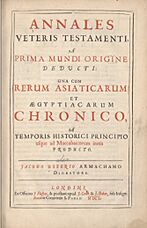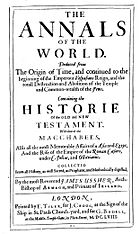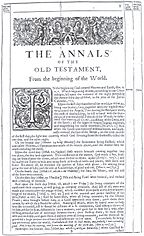Ussher chronology facts for kids
The Ussher chronology is a way of figuring out the age of the world. It was created in the 1600s by James Ussher. He was an important religious leader called the Archbishop of Armagh in Ireland. Ussher used the Old Testament part of the Bible to calculate his dates.
His work is sometimes linked to young Earth creationism. This idea suggests that God created the universe only a few thousand years ago. This is based on the first two chapters of the Book of Genesis in the Bible. However, Ussher's ideas became less popular in the 1800s.
Ussher's full book was published in 1650. Its Latin title was Annales Veteris Testamenti, a prima mundi origine deducti. This means 'Annals of the Old Testament, traced from the world's first origins'. It also included a history of Asian and Egyptian events.
Ussher's work was part of a big discussion at the time about how old the Earth is. Many Christian scholars had been trying to figure this out for centuries.
The Ussher chronology is sometimes also called the Ussher-Lightfoot chronology. This is because John Lightfoot published a similar timeline in the 1640s. But Ussher's work is actually based only on his own research, not Lightfoot's. Ussher calculated that the first day of creation happened on October 22, 4004 BC. This was close to the autumnal equinox. Lightfoot thought creation began in 3929 BC.
Ussher's date of 4004 BC was similar to other dates calculated from the Bible. For example, Bede suggested 3952 BC, and Johannes Kepler thought it was 3992 BC. Even Isaac Newton estimated around 4000 BC. Ussher also believed the worldwide flood happened in 2349 BC. The idea that the Earth was about 5600 years old was common. This was based on the belief that "one day is with the Lord as a thousand years" (2 Peter 3:8). This meant the six days of creation could represent 6000 years.
How Ussher Calculated His Chronology
Ussher and other Bible scholars used similar ways to figure out dates from the Bible. It was tricky because the Bible was written by many different people over hundreds of years. There were also long gaps in the timeline.
A scholar named James Barr explained three main periods Ussher had to work with:
- From Creation to Abraham's Journey: This part was fairly easy to calculate. The books of Genesis 5 and 11 give a clear family tree with ages. This goes from creation up to Abraham leaving Ur. Ussher used the Masoretic text of the Bible for his calculations. He set this period as 2082 years, from 4004 BC to 1922 BC.
- From Abraham's Journey to Solomon's Temple: Ussher believed 430 years passed from Abraham leaving Haran to the Exodus. The Bible (1 Kings 6) says 480 years went by from the Exodus to the start of Solomon's Temple construction. So, the temple's foundations were laid 910 years after Abraham left Haran. This period was from 1922 BC to 1012 BC.
- From Solomon's Temple to the Babylonian Captivity: This was the hardest period to calculate. It was tough to match up the years that the kings of Judah and Israel ruled. Adding up the reigns of Judah's kings gives 430 years. But Ussher made it 424 years by suggesting some reigns overlapped. This period was from 1012 BC to 588 BC.
After figuring out the years from creation to the last kings of Judah, Ussher used a Bible verse (2 Kings 25:27) to find the time from creation to the rule of the Babylonian king Amel-Marduk. Then, he used information from Babylonian, Greek, and Roman records. He set Amel-Marduk's start date as 562 BC. From this, he could figure out that creation happened in 4004 BC.
When figuring out the date of Jesus' birth, Ussher corrected a mistake made by Dionysius Exiguus. This person created the Anno Domini (AD) calendar system. Ussher chose 5 BC as Christ's birth year. This was because Josephus wrote that Herod the Great died in 4 BC. For the Gospel of Matthew to be right, Jesus could not have been born after that date.
The time of year when creation happened was a big debate in Ussher's time. Many scholars thought it was in the spring. This is when many ancient cultures started their calendars. But others, including Ussher, thought autumn was more likely. This is because the Jewish year begins in the autumn.
Ussher further narrowed down the date using the Hebrew calendar. He decided the "first day" of creation was a Sunday near the autumnal equinox. He worked backward from the idea that God rested on the seventh day (Saturday). So, creation must have started on a Sunday. Ussher likely used Johannes Kepler's Rudolphine Tables (1627) for his astronomy. Modern calculations show the autumnal equinox of 4004 BC was on Sunday, October 23.
Ussher believed the "first day" in Genesis 1:5 was October 23. But he also thought there was a "pre-creation" event, the "beginning of time," the night before. Ussher wrote about his dating of creation on the first page of his book Annales. He also mentioned it in the English translation, Annals of the World (1658).
Here's what he wrote in the English translation:
In the beginning God created the heaven and the earth. Ge. 1:1 This beginning of time, according to our chronology, happened at the start of the evening preceding the 23rd day of October in the year of the Julian Calendar, 710.
Ussher gave a slightly different time in his "Epistle to the Reader": "I deduce that the time from the creation until midnight, January 1, 1 AD was 4003 years, seventy days and six hours." Six hours before midnight would be 6 pm.
The Ussher Chronology Today
By the mid-1800s, Ussher's chronology faced many challenges. Scientists who believed in uniformitarianism argued that the Earth was much older than Ussher's "young Earth" idea. It became widely accepted that the Earth was millions, or even hundreds of millions, of years old.
Ussher's ideas also became less popular among religious scholars. In 1890, William Henry Green wrote an important article. He argued that the Bible does not give exact dates for the Flood or the creation of the world. Another scholar, B. B. Warfield, agreed. He said it was risky to get exact dates from family trees in the Bible.
Archbishop Ussher's chronology has also been mentioned in plays and books. For example, the play Inherit the Wind and the fantasy novel Good Omens talk about it.
However, some people, like scientist Stephen Jay Gould, have defended Ussher's work. Gould disagreed with the chronology itself. But he said Ussher's work was "an honorable effort for its time." He believed Ussher was a top scholar of his era. Ussher was part of a large group of thinkers working towards a common goal.
See also
- Chronology of the Bible
- Anno Mundi
- Anno Lucis





